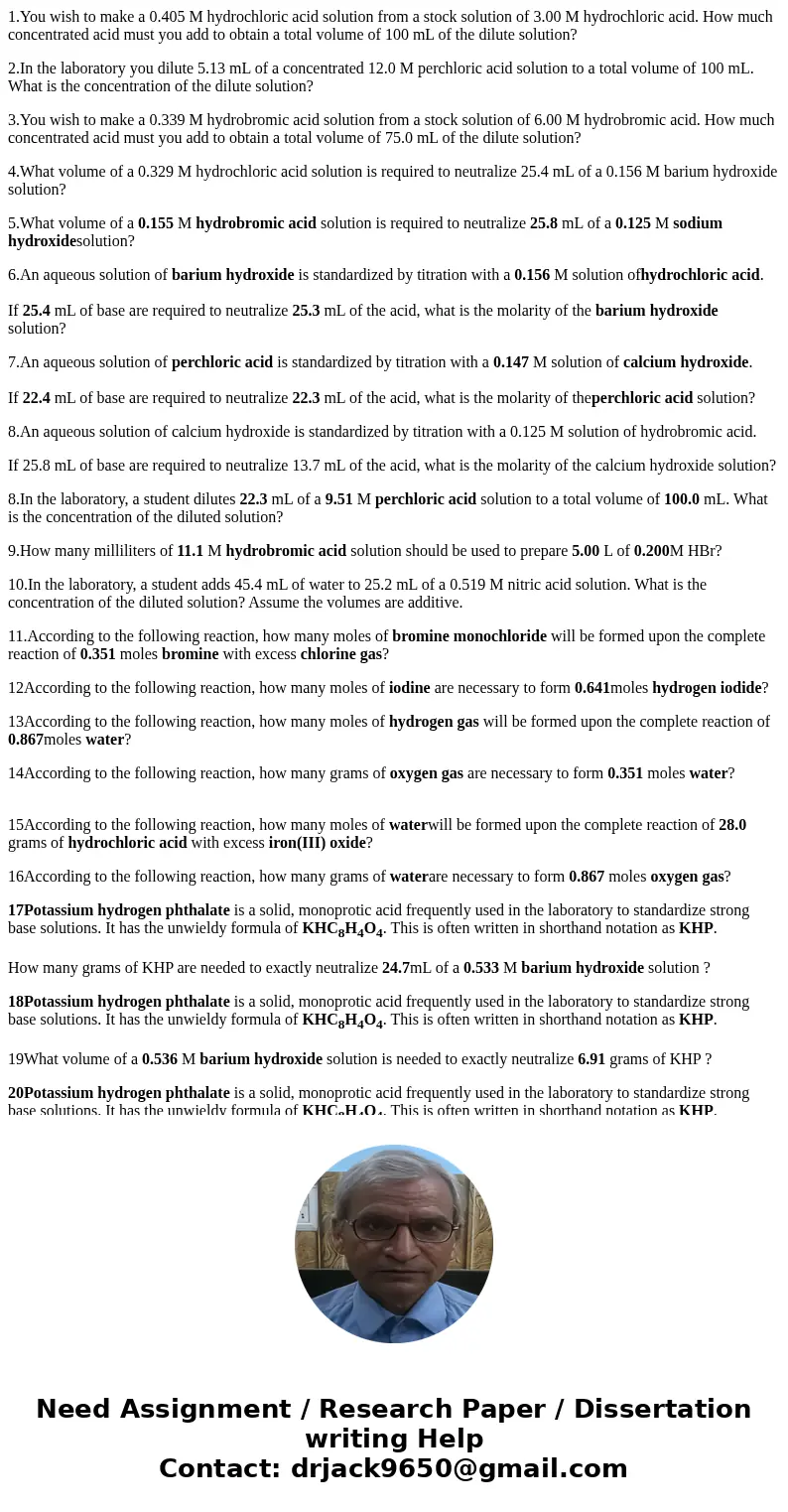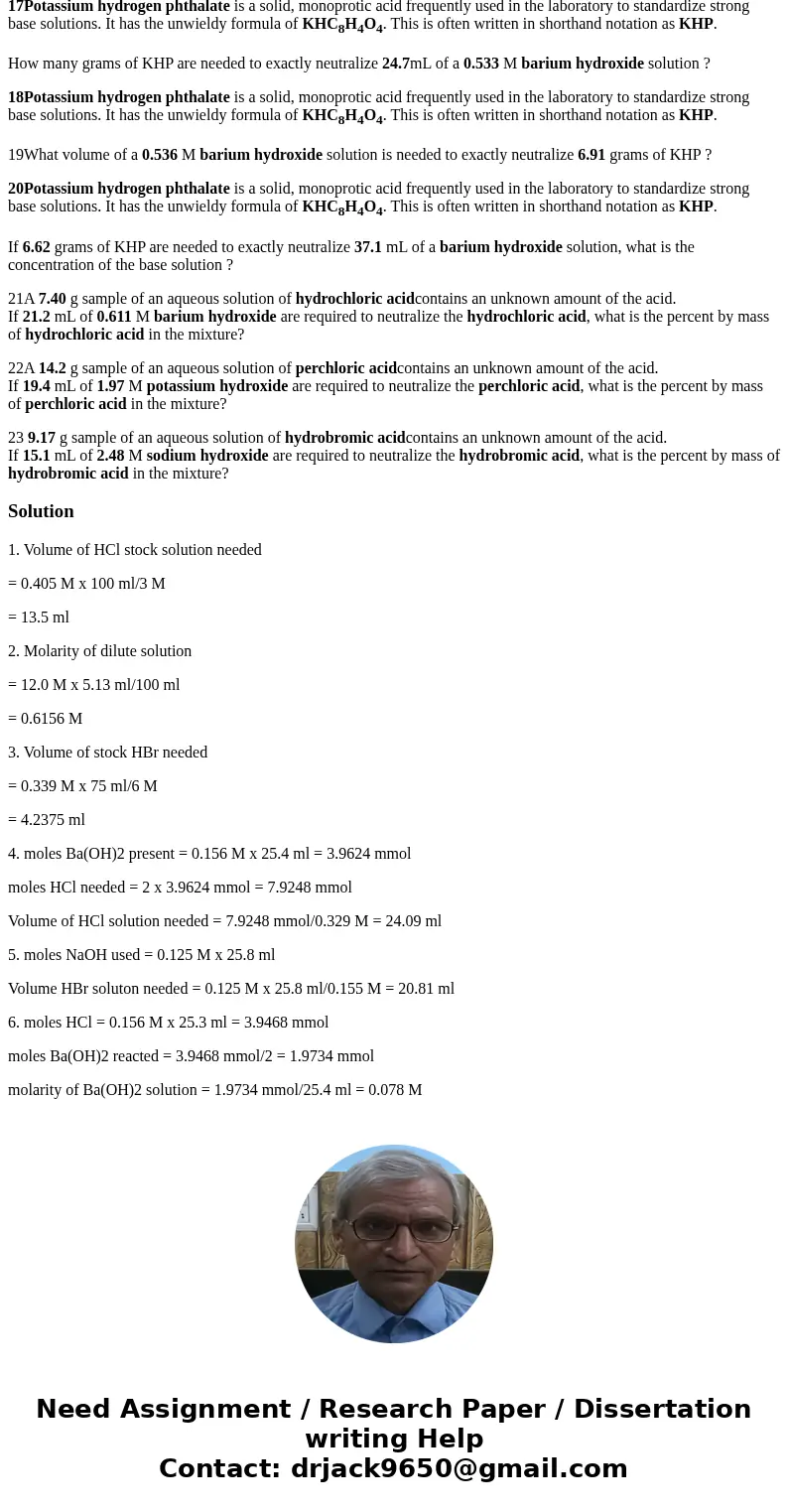1You wish to make a 0405 M hydrochloric acid solution from a
1.You wish to make a 0.405 M hydrochloric acid solution from a stock solution of 3.00 M hydrochloric acid. How much concentrated acid must you add to obtain a total volume of 100 mL of the dilute solution?
2.In the laboratory you dilute 5.13 mL of a concentrated 12.0 M perchloric acid solution to a total volume of 100 mL. What is the concentration of the dilute solution?
3.You wish to make a 0.339 M hydrobromic acid solution from a stock solution of 6.00 M hydrobromic acid. How much concentrated acid must you add to obtain a total volume of 75.0 mL of the dilute solution?
4.What volume of a 0.329 M hydrochloric acid solution is required to neutralize 25.4 mL of a 0.156 M barium hydroxide solution?
5.What volume of a 0.155 M hydrobromic acid solution is required to neutralize 25.8 mL of a 0.125 M sodium hydroxidesolution?
6.An aqueous solution of barium hydroxide is standardized by titration with a 0.156 M solution ofhydrochloric acid.
If 25.4 mL of base are required to neutralize 25.3 mL of the acid, what is the molarity of the barium hydroxide solution?
7.An aqueous solution of perchloric acid is standardized by titration with a 0.147 M solution of calcium hydroxide.
If 22.4 mL of base are required to neutralize 22.3 mL of the acid, what is the molarity of theperchloric acid solution?
8.An aqueous solution of calcium hydroxide is standardized by titration with a 0.125 M solution of hydrobromic acid.
If 25.8 mL of base are required to neutralize 13.7 mL of the acid, what is the molarity of the calcium hydroxide solution?
8.In the laboratory, a student dilutes 22.3 mL of a 9.51 M perchloric acid solution to a total volume of 100.0 mL. What is the concentration of the diluted solution?
9.How many milliliters of 11.1 M hydrobromic acid solution should be used to prepare 5.00 L of 0.200M HBr?
10.In the laboratory, a student adds 45.4 mL of water to 25.2 mL of a 0.519 M nitric acid solution. What is the concentration of the diluted solution? Assume the volumes are additive.
11.According to the following reaction, how many moles of bromine monochloride will be formed upon the complete reaction of 0.351 moles bromine with excess chlorine gas?
12According to the following reaction, how many moles of iodine are necessary to form 0.641moles hydrogen iodide?
13According to the following reaction, how many moles of hydrogen gas will be formed upon the complete reaction of 0.867moles water?
14According to the following reaction, how many grams of oxygen gas are necessary to form 0.351 moles water?
15According to the following reaction, how many moles of waterwill be formed upon the complete reaction of 28.0 grams of hydrochloric acid with excess iron(III) oxide?
16According to the following reaction, how many grams of waterare necessary to form 0.867 moles oxygen gas?
17Potassium hydrogen phthalate is a solid, monoprotic acid frequently used in the laboratory to standardize strong base solutions. It has the unwieldy formula of KHC8H4O4. This is often written in shorthand notation as KHP.
How many grams of KHP are needed to exactly neutralize 24.7mL of a 0.533 M barium hydroxide solution ?
18Potassium hydrogen phthalate is a solid, monoprotic acid frequently used in the laboratory to standardize strong base solutions. It has the unwieldy formula of KHC8H4O4. This is often written in shorthand notation as KHP.
19What volume of a 0.536 M barium hydroxide solution is needed to exactly neutralize 6.91 grams of KHP ?
20Potassium hydrogen phthalate is a solid, monoprotic acid frequently used in the laboratory to standardize strong base solutions. It has the unwieldy formula of KHC8H4O4. This is often written in shorthand notation as KHP.
If 6.62 grams of KHP are needed to exactly neutralize 37.1 mL of a barium hydroxide solution, what is the concentration of the base solution ?
21A 7.40 g sample of an aqueous solution of hydrochloric acidcontains an unknown amount of the acid.
If 21.2 mL of 0.611 M barium hydroxide are required to neutralize the hydrochloric acid, what is the percent by mass of hydrochloric acid in the mixture?
22A 14.2 g sample of an aqueous solution of perchloric acidcontains an unknown amount of the acid.
If 19.4 mL of 1.97 M potassium hydroxide are required to neutralize the perchloric acid, what is the percent by mass of perchloric acid in the mixture?
23 9.17 g sample of an aqueous solution of hydrobromic acidcontains an unknown amount of the acid.
If 15.1 mL of 2.48 M sodium hydroxide are required to neutralize the hydrobromic acid, what is the percent by mass of hydrobromic acid in the mixture?
Solution
1. Volume of HCl stock solution needed
= 0.405 M x 100 ml/3 M
= 13.5 ml
2. Molarity of dilute solution
= 12.0 M x 5.13 ml/100 ml
= 0.6156 M
3. Volume of stock HBr needed
= 0.339 M x 75 ml/6 M
= 4.2375 ml
4. moles Ba(OH)2 present = 0.156 M x 25.4 ml = 3.9624 mmol
moles HCl needed = 2 x 3.9624 mmol = 7.9248 mmol
Volume of HCl solution needed = 7.9248 mmol/0.329 M = 24.09 ml
5. moles NaOH used = 0.125 M x 25.8 ml
Volume HBr soluton needed = 0.125 M x 25.8 ml/0.155 M = 20.81 ml
6. moles HCl = 0.156 M x 25.3 ml = 3.9468 mmol
moles Ba(OH)2 reacted = 3.9468 mmol/2 = 1.9734 mmol
molarity of Ba(OH)2 solution = 1.9734 mmol/25.4 ml = 0.078 M


 Homework Sourse
Homework Sourse